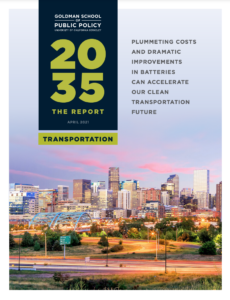Full Title: 2035 Report: Plummeting Costs & Dramatic Improvements in Batteries can Accelerate our Clean Transportation Future
Author(s): Amol Phadke, Nikit Abhyankar, Jessica Kersey, Taylor McNair, Umed Paliwal, David Wooley, Olivia Ashmoore, Robbie Orvis, Michael O’Boyle, Ric O’Connell, Utkarsha Agwan, Priyanka Mohanty, Priya Sreedharan, Deepak Rajagopal
Publisher(s): Goldman School of Public Policy at the University of California, Berkeley
Publication Date: April 15, 2021
Full Text: Download Resource
Description (excerpt):
Global carbon emissions must be halved by 2030 to limit warming to 1.5°C and avoid catastrophic climate impacts. The U.S. transportation sector is the country’s largest carbon emitter and a challenging piece of the decarbonization puzzle. Fortunately, recent advances in electric vehicle (EV) battery cost and performance, range, and recharging—along with a proliferation of vehicle models—have readied EVs to overtake gasoline and diesel vehicles as the dominant on-road technology. Now that the plummeting cost of wind and solar power have enabled a rapid and cost-effective expansion of a clean electricity grid, a cost-effective pathway to decarbonize the transportation sector is in reach. Yet electric vehicles make up only a small part of today’s U.S. vehicle fleet, and many sales projections for the next decade are modest. Several hurdles, including high upfront vehicle costs and inadequate charging infrastructure, rather than technical or economic feasibility, are the largest barriers to EV sales growth and accelerated decarbonization to align with global climate targets.
In this report, we analyze the economic, human health, environmental, and electric grid impacts of a future in which ground transportation is all-electric. Our main scenario, the Drive Rapid Innovation in Vehicle Electrification (DRIVE Clean) scenario, represents a future in which EVs constitute 100% of new U.S. light-duty vehicle (LDV) sales by 2030 as well as 100% of medium-duty vehicle (MDV) and heavy-duty truck (HDT) sales by 2035. The grid reaches 90% clean electricity by 2035, and substantial EV charging infrastructure is deployed. We compare this scenario to a No New Policy scenario, in which EVs constitute 45% of new LDV sales, 38% of MDV sales, and 12% of HDT sales in 2035, and the clean electricity share reaches only 47% by 2035. By demonstrating that the ambitious DRIVE Clean goals are technically feasible and economically beneficial, we aim to inform broader discussions of the U.S. transportation transition. Following are key findings from our analysis.
